Critical Reflection: Experience in Assessing Abdominal Pain Patient
VerifiedAdded on 2023/06/04
|6
|1669
|298
Practical Assignment
AI Summary
This assignment is a critical reflection on a nursing student's experience assessing a 75-year-old male patient presenting with abdominal pain, suspected to be related to appendicitis. The student details the assessment process, including inspection, palpation, percussion, and auscultation, and the patient's anxiety and pain levels. The reflection analyzes the student's feelings, evaluates the assessment, and identifies issues related to patient safety and communication. The analysis emphasizes the importance of patient-centered care, ethical considerations, and the involvement of family members. The conclusion highlights areas for improvement, such as enhanced communication skills and improved clinical decision-making. An action plan outlines strategies for professional development, including communication skills, clinical decision-making, and training in patient safety and cultural competency. The reflection also emphasizes the importance of adhering to ethical standards and creating a holistic care plan.
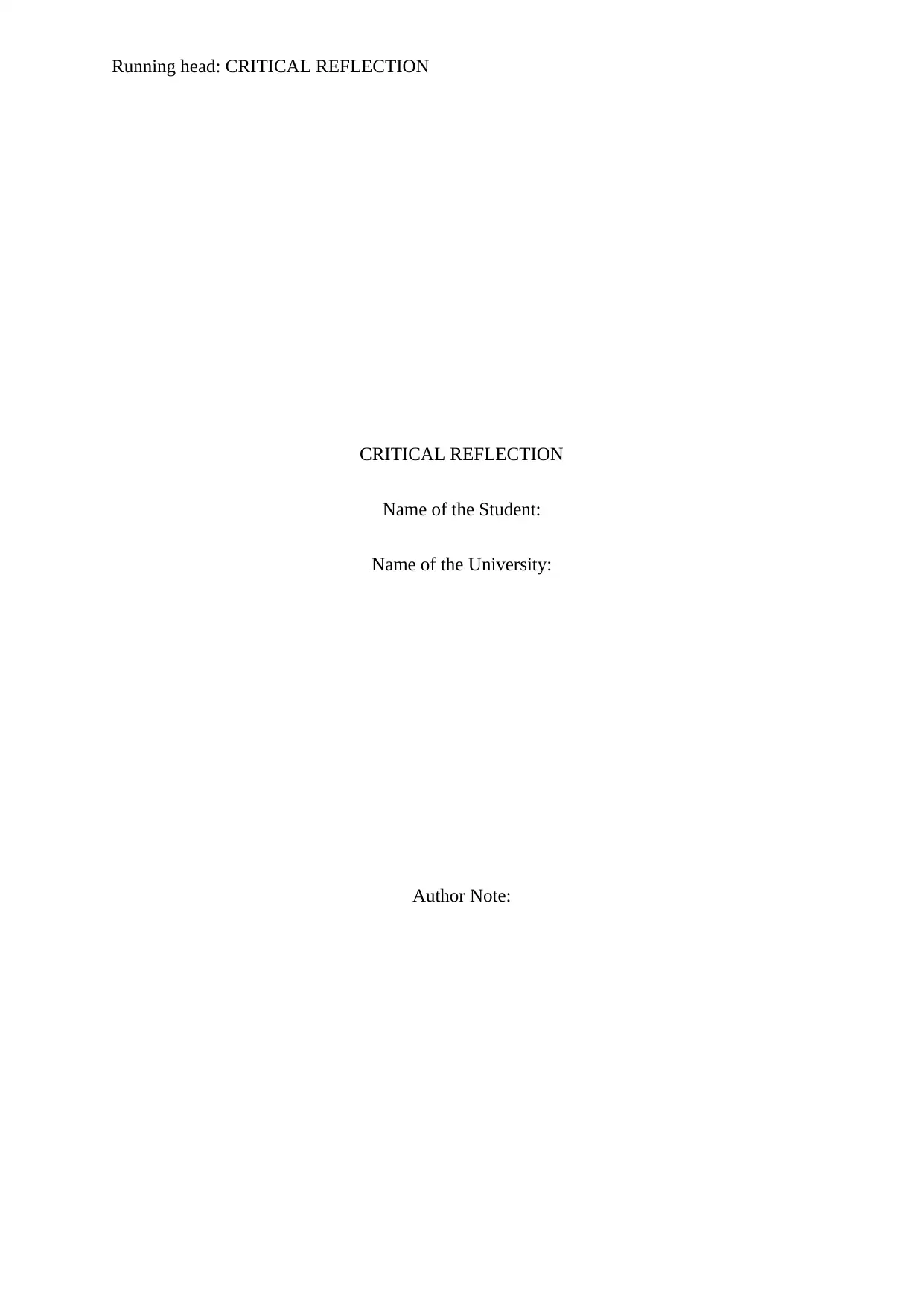
Running head: CRITICAL REFLECTION
CRITICAL REFLECTION
Name of the Student:
Name of the University:
Author Note:
CRITICAL REFLECTION
Name of the Student:
Name of the University:
Author Note:
Paraphrase This Document
Need a fresh take? Get an instant paraphrase of this document with our AI Paraphraser
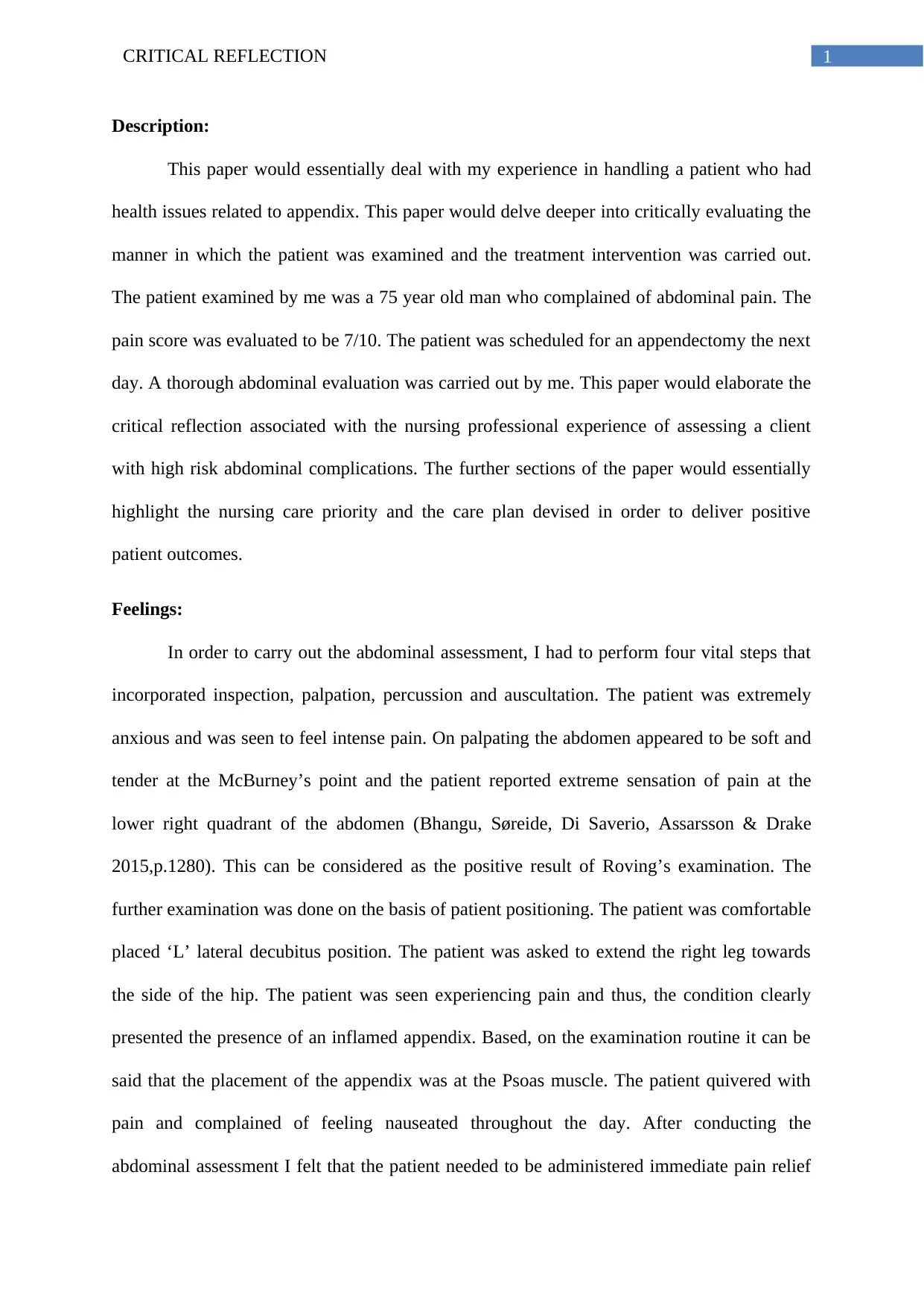
1CRITICAL REFLECTION
Description:
This paper would essentially deal with my experience in handling a patient who had
health issues related to appendix. This paper would delve deeper into critically evaluating the
manner in which the patient was examined and the treatment intervention was carried out.
The patient examined by me was a 75 year old man who complained of abdominal pain. The
pain score was evaluated to be 7/10. The patient was scheduled for an appendectomy the next
day. A thorough abdominal evaluation was carried out by me. This paper would elaborate the
critical reflection associated with the nursing professional experience of assessing a client
with high risk abdominal complications. The further sections of the paper would essentially
highlight the nursing care priority and the care plan devised in order to deliver positive
patient outcomes.
Feelings:
In order to carry out the abdominal assessment, I had to perform four vital steps that
incorporated inspection, palpation, percussion and auscultation. The patient was extremely
anxious and was seen to feel intense pain. On palpating the abdomen appeared to be soft and
tender at the McBurney’s point and the patient reported extreme sensation of pain at the
lower right quadrant of the abdomen (Bhangu, Søreide, Di Saverio, Assarsson & Drake
2015,p.1280). This can be considered as the positive result of Roving’s examination. The
further examination was done on the basis of patient positioning. The patient was comfortable
placed ‘L’ lateral decubitus position. The patient was asked to extend the right leg towards
the side of the hip. The patient was seen experiencing pain and thus, the condition clearly
presented the presence of an inflamed appendix. Based, on the examination routine it can be
said that the placement of the appendix was at the Psoas muscle. The patient quivered with
pain and complained of feeling nauseated throughout the day. After conducting the
abdominal assessment I felt that the patient needed to be administered immediate pain relief
Description:
This paper would essentially deal with my experience in handling a patient who had
health issues related to appendix. This paper would delve deeper into critically evaluating the
manner in which the patient was examined and the treatment intervention was carried out.
The patient examined by me was a 75 year old man who complained of abdominal pain. The
pain score was evaluated to be 7/10. The patient was scheduled for an appendectomy the next
day. A thorough abdominal evaluation was carried out by me. This paper would elaborate the
critical reflection associated with the nursing professional experience of assessing a client
with high risk abdominal complications. The further sections of the paper would essentially
highlight the nursing care priority and the care plan devised in order to deliver positive
patient outcomes.
Feelings:
In order to carry out the abdominal assessment, I had to perform four vital steps that
incorporated inspection, palpation, percussion and auscultation. The patient was extremely
anxious and was seen to feel intense pain. On palpating the abdomen appeared to be soft and
tender at the McBurney’s point and the patient reported extreme sensation of pain at the
lower right quadrant of the abdomen (Bhangu, Søreide, Di Saverio, Assarsson & Drake
2015,p.1280). This can be considered as the positive result of Roving’s examination. The
further examination was done on the basis of patient positioning. The patient was comfortable
placed ‘L’ lateral decubitus position. The patient was asked to extend the right leg towards
the side of the hip. The patient was seen experiencing pain and thus, the condition clearly
presented the presence of an inflamed appendix. Based, on the examination routine it can be
said that the placement of the appendix was at the Psoas muscle. The patient quivered with
pain and complained of feeling nauseated throughout the day. After conducting the
abdominal assessment I felt that the patient needed to be administered immediate pain relief
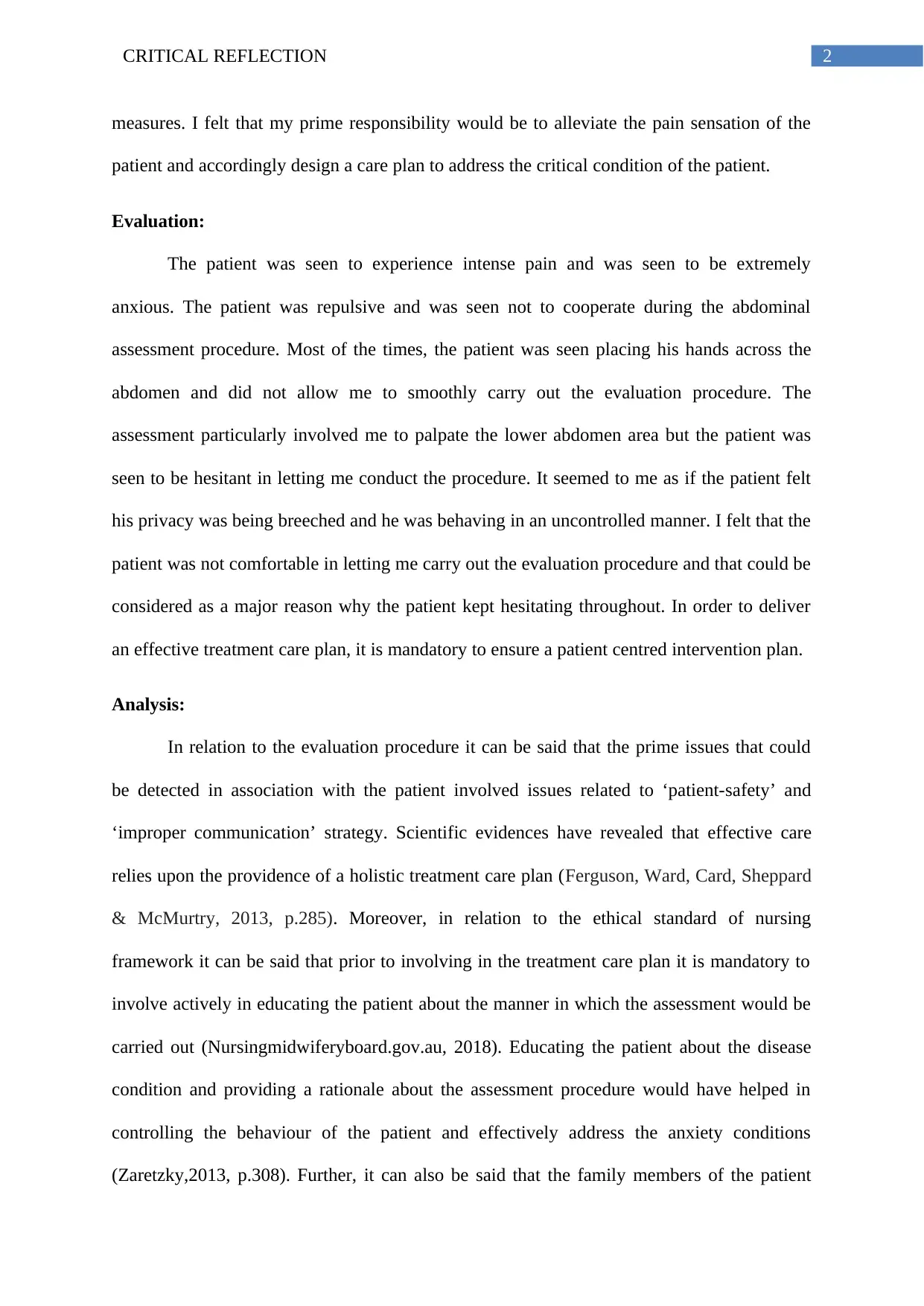
2CRITICAL REFLECTION
measures. I felt that my prime responsibility would be to alleviate the pain sensation of the
patient and accordingly design a care plan to address the critical condition of the patient.
Evaluation:
The patient was seen to experience intense pain and was seen to be extremely
anxious. The patient was repulsive and was seen not to cooperate during the abdominal
assessment procedure. Most of the times, the patient was seen placing his hands across the
abdomen and did not allow me to smoothly carry out the evaluation procedure. The
assessment particularly involved me to palpate the lower abdomen area but the patient was
seen to be hesitant in letting me conduct the procedure. It seemed to me as if the patient felt
his privacy was being breeched and he was behaving in an uncontrolled manner. I felt that the
patient was not comfortable in letting me carry out the evaluation procedure and that could be
considered as a major reason why the patient kept hesitating throughout. In order to deliver
an effective treatment care plan, it is mandatory to ensure a patient centred intervention plan.
Analysis:
In relation to the evaluation procedure it can be said that the prime issues that could
be detected in association with the patient involved issues related to ‘patient-safety’ and
‘improper communication’ strategy. Scientific evidences have revealed that effective care
relies upon the providence of a holistic treatment care plan (Ferguson, Ward, Card, Sheppard
& McMurtry, 2013, p.285). Moreover, in relation to the ethical standard of nursing
framework it can be said that prior to involving in the treatment care plan it is mandatory to
involve actively in educating the patient about the manner in which the assessment would be
carried out (Nursingmidwiferyboard.gov.au, 2018). Educating the patient about the disease
condition and providing a rationale about the assessment procedure would have helped in
controlling the behaviour of the patient and effectively address the anxiety conditions
(Zaretzky,2013, p.308). Further, it can also be said that the family members of the patient
measures. I felt that my prime responsibility would be to alleviate the pain sensation of the
patient and accordingly design a care plan to address the critical condition of the patient.
Evaluation:
The patient was seen to experience intense pain and was seen to be extremely
anxious. The patient was repulsive and was seen not to cooperate during the abdominal
assessment procedure. Most of the times, the patient was seen placing his hands across the
abdomen and did not allow me to smoothly carry out the evaluation procedure. The
assessment particularly involved me to palpate the lower abdomen area but the patient was
seen to be hesitant in letting me conduct the procedure. It seemed to me as if the patient felt
his privacy was being breeched and he was behaving in an uncontrolled manner. I felt that the
patient was not comfortable in letting me carry out the evaluation procedure and that could be
considered as a major reason why the patient kept hesitating throughout. In order to deliver
an effective treatment care plan, it is mandatory to ensure a patient centred intervention plan.
Analysis:
In relation to the evaluation procedure it can be said that the prime issues that could
be detected in association with the patient involved issues related to ‘patient-safety’ and
‘improper communication’ strategy. Scientific evidences have revealed that effective care
relies upon the providence of a holistic treatment care plan (Ferguson, Ward, Card, Sheppard
& McMurtry, 2013, p.285). Moreover, in relation to the ethical standard of nursing
framework it can be said that prior to involving in the treatment care plan it is mandatory to
involve actively in educating the patient about the manner in which the assessment would be
carried out (Nursingmidwiferyboard.gov.au, 2018). Educating the patient about the disease
condition and providing a rationale about the assessment procedure would have helped in
controlling the behaviour of the patient and effectively address the anxiety conditions
(Zaretzky,2013, p.308). Further, it can also be said that the family members of the patient
⊘ This is a preview!⊘
Do you want full access?
Subscribe today to unlock all pages.

Trusted by 1+ million students worldwide
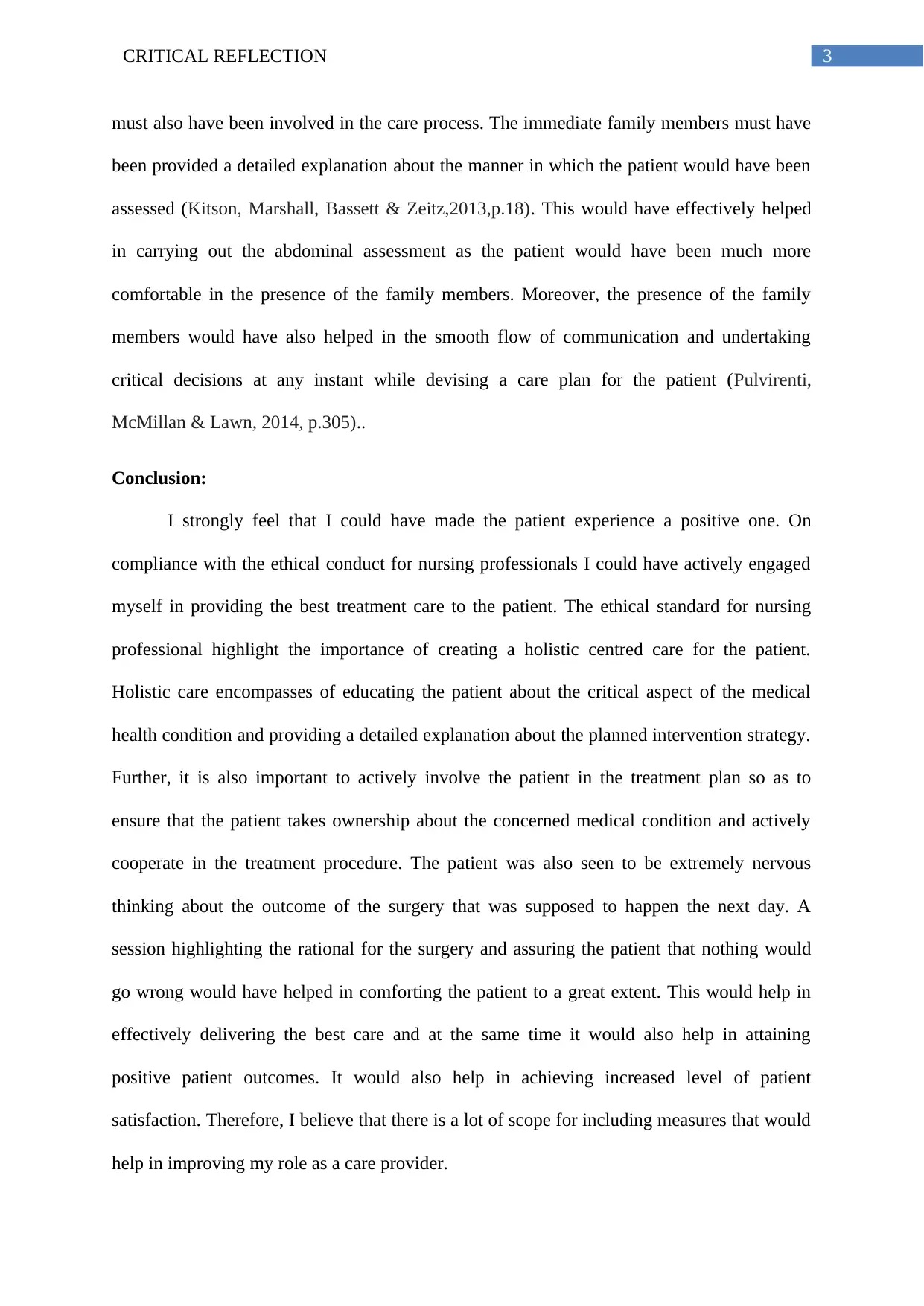
3CRITICAL REFLECTION
must also have been involved in the care process. The immediate family members must have
been provided a detailed explanation about the manner in which the patient would have been
assessed (Kitson, Marshall, Bassett & Zeitz,2013,p.18). This would have effectively helped
in carrying out the abdominal assessment as the patient would have been much more
comfortable in the presence of the family members. Moreover, the presence of the family
members would have also helped in the smooth flow of communication and undertaking
critical decisions at any instant while devising a care plan for the patient (Pulvirenti,
McMillan & Lawn, 2014, p.305)..
Conclusion:
I strongly feel that I could have made the patient experience a positive one. On
compliance with the ethical conduct for nursing professionals I could have actively engaged
myself in providing the best treatment care to the patient. The ethical standard for nursing
professional highlight the importance of creating a holistic centred care for the patient.
Holistic care encompasses of educating the patient about the critical aspect of the medical
health condition and providing a detailed explanation about the planned intervention strategy.
Further, it is also important to actively involve the patient in the treatment plan so as to
ensure that the patient takes ownership about the concerned medical condition and actively
cooperate in the treatment procedure. The patient was also seen to be extremely nervous
thinking about the outcome of the surgery that was supposed to happen the next day. A
session highlighting the rational for the surgery and assuring the patient that nothing would
go wrong would have helped in comforting the patient to a great extent. This would help in
effectively delivering the best care and at the same time it would also help in attaining
positive patient outcomes. It would also help in achieving increased level of patient
satisfaction. Therefore, I believe that there is a lot of scope for including measures that would
help in improving my role as a care provider.
must also have been involved in the care process. The immediate family members must have
been provided a detailed explanation about the manner in which the patient would have been
assessed (Kitson, Marshall, Bassett & Zeitz,2013,p.18). This would have effectively helped
in carrying out the abdominal assessment as the patient would have been much more
comfortable in the presence of the family members. Moreover, the presence of the family
members would have also helped in the smooth flow of communication and undertaking
critical decisions at any instant while devising a care plan for the patient (Pulvirenti,
McMillan & Lawn, 2014, p.305)..
Conclusion:
I strongly feel that I could have made the patient experience a positive one. On
compliance with the ethical conduct for nursing professionals I could have actively engaged
myself in providing the best treatment care to the patient. The ethical standard for nursing
professional highlight the importance of creating a holistic centred care for the patient.
Holistic care encompasses of educating the patient about the critical aspect of the medical
health condition and providing a detailed explanation about the planned intervention strategy.
Further, it is also important to actively involve the patient in the treatment plan so as to
ensure that the patient takes ownership about the concerned medical condition and actively
cooperate in the treatment procedure. The patient was also seen to be extremely nervous
thinking about the outcome of the surgery that was supposed to happen the next day. A
session highlighting the rational for the surgery and assuring the patient that nothing would
go wrong would have helped in comforting the patient to a great extent. This would help in
effectively delivering the best care and at the same time it would also help in attaining
positive patient outcomes. It would also help in achieving increased level of patient
satisfaction. Therefore, I believe that there is a lot of scope for including measures that would
help in improving my role as a care provider.
Paraphrase This Document
Need a fresh take? Get an instant paraphrase of this document with our AI Paraphraser
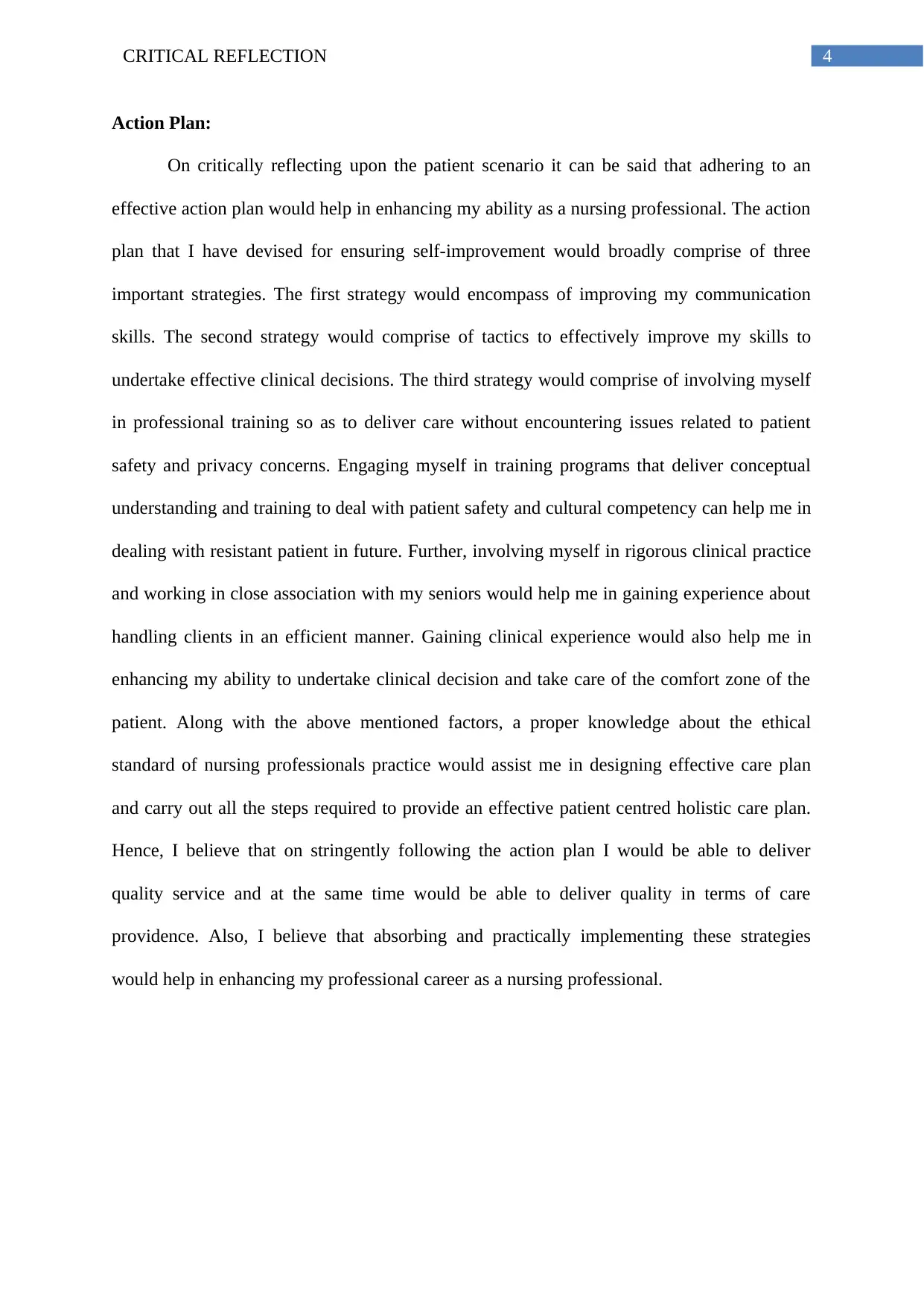
4CRITICAL REFLECTION
Action Plan:
On critically reflecting upon the patient scenario it can be said that adhering to an
effective action plan would help in enhancing my ability as a nursing professional. The action
plan that I have devised for ensuring self-improvement would broadly comprise of three
important strategies. The first strategy would encompass of improving my communication
skills. The second strategy would comprise of tactics to effectively improve my skills to
undertake effective clinical decisions. The third strategy would comprise of involving myself
in professional training so as to deliver care without encountering issues related to patient
safety and privacy concerns. Engaging myself in training programs that deliver conceptual
understanding and training to deal with patient safety and cultural competency can help me in
dealing with resistant patient in future. Further, involving myself in rigorous clinical practice
and working in close association with my seniors would help me in gaining experience about
handling clients in an efficient manner. Gaining clinical experience would also help me in
enhancing my ability to undertake clinical decision and take care of the comfort zone of the
patient. Along with the above mentioned factors, a proper knowledge about the ethical
standard of nursing professionals practice would assist me in designing effective care plan
and carry out all the steps required to provide an effective patient centred holistic care plan.
Hence, I believe that on stringently following the action plan I would be able to deliver
quality service and at the same time would be able to deliver quality in terms of care
providence. Also, I believe that absorbing and practically implementing these strategies
would help in enhancing my professional career as a nursing professional.
Action Plan:
On critically reflecting upon the patient scenario it can be said that adhering to an
effective action plan would help in enhancing my ability as a nursing professional. The action
plan that I have devised for ensuring self-improvement would broadly comprise of three
important strategies. The first strategy would encompass of improving my communication
skills. The second strategy would comprise of tactics to effectively improve my skills to
undertake effective clinical decisions. The third strategy would comprise of involving myself
in professional training so as to deliver care without encountering issues related to patient
safety and privacy concerns. Engaging myself in training programs that deliver conceptual
understanding and training to deal with patient safety and cultural competency can help me in
dealing with resistant patient in future. Further, involving myself in rigorous clinical practice
and working in close association with my seniors would help me in gaining experience about
handling clients in an efficient manner. Gaining clinical experience would also help me in
enhancing my ability to undertake clinical decision and take care of the comfort zone of the
patient. Along with the above mentioned factors, a proper knowledge about the ethical
standard of nursing professionals practice would assist me in designing effective care plan
and carry out all the steps required to provide an effective patient centred holistic care plan.
Hence, I believe that on stringently following the action plan I would be able to deliver
quality service and at the same time would be able to deliver quality in terms of care
providence. Also, I believe that absorbing and practically implementing these strategies
would help in enhancing my professional career as a nursing professional.
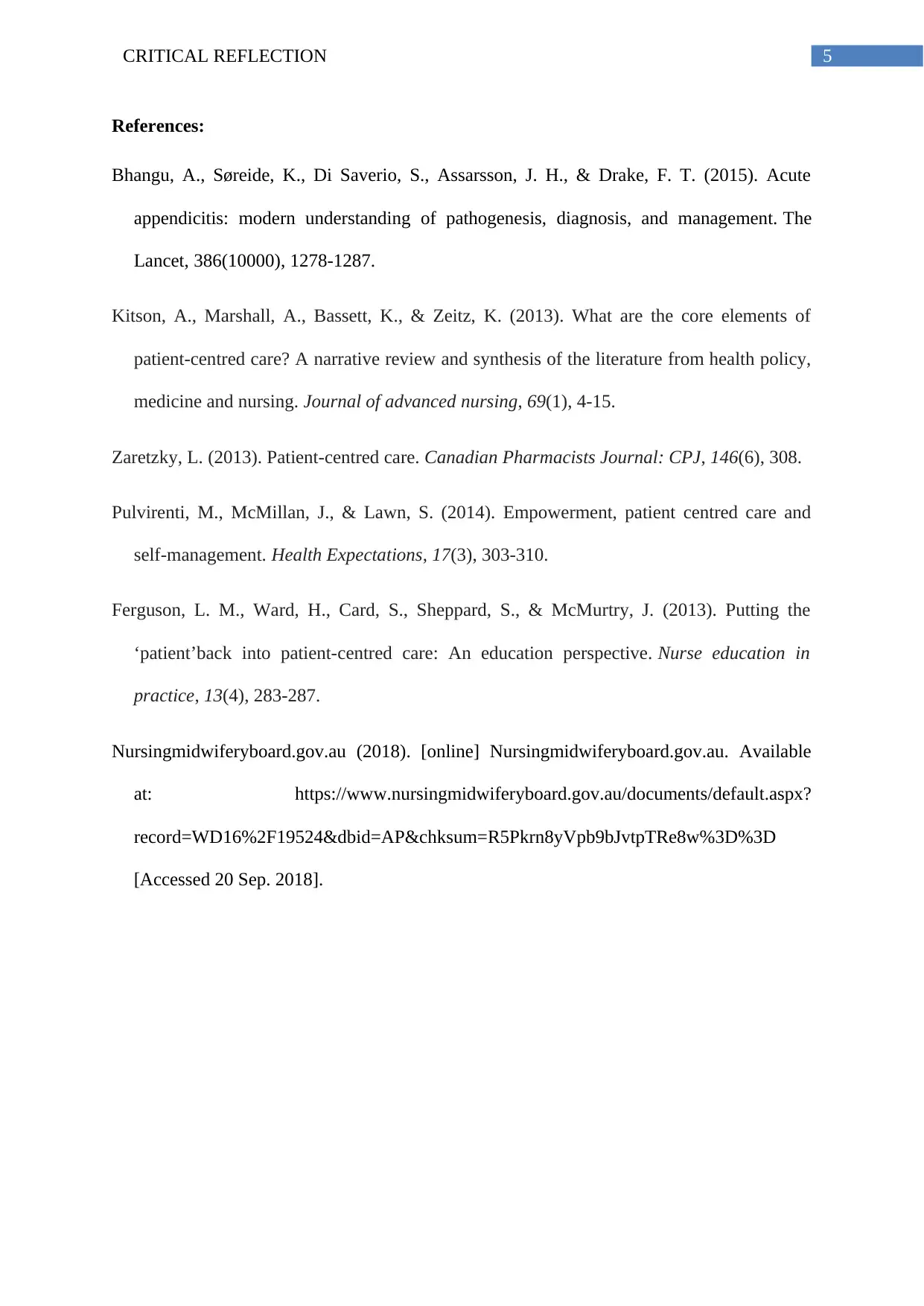
5CRITICAL REFLECTION
References:
Bhangu, A., Søreide, K., Di Saverio, S., Assarsson, J. H., & Drake, F. T. (2015). Acute
appendicitis: modern understanding of pathogenesis, diagnosis, and management. The
Lancet, 386(10000), 1278-1287.
Kitson, A., Marshall, A., Bassett, K., & Zeitz, K. (2013). What are the core elements of
patient‐centred care? A narrative review and synthesis of the literature from health policy,
medicine and nursing. Journal of advanced nursing, 69(1), 4-15.
Zaretzky, L. (2013). Patient-centred care. Canadian Pharmacists Journal: CPJ, 146(6), 308.
Pulvirenti, M., McMillan, J., & Lawn, S. (2014). Empowerment, patient centred care and
self‐management. Health Expectations, 17(3), 303-310.
Ferguson, L. M., Ward, H., Card, S., Sheppard, S., & McMurtry, J. (2013). Putting the
‘patient’back into patient-centred care: An education perspective. Nurse education in
practice, 13(4), 283-287.
Nursingmidwiferyboard.gov.au (2018). [online] Nursingmidwiferyboard.gov.au. Available
at: https://www.nursingmidwiferyboard.gov.au/documents/default.aspx?
record=WD16%2F19524&dbid=AP&chksum=R5Pkrn8yVpb9bJvtpTRe8w%3D%3D
[Accessed 20 Sep. 2018].
References:
Bhangu, A., Søreide, K., Di Saverio, S., Assarsson, J. H., & Drake, F. T. (2015). Acute
appendicitis: modern understanding of pathogenesis, diagnosis, and management. The
Lancet, 386(10000), 1278-1287.
Kitson, A., Marshall, A., Bassett, K., & Zeitz, K. (2013). What are the core elements of
patient‐centred care? A narrative review and synthesis of the literature from health policy,
medicine and nursing. Journal of advanced nursing, 69(1), 4-15.
Zaretzky, L. (2013). Patient-centred care. Canadian Pharmacists Journal: CPJ, 146(6), 308.
Pulvirenti, M., McMillan, J., & Lawn, S. (2014). Empowerment, patient centred care and
self‐management. Health Expectations, 17(3), 303-310.
Ferguson, L. M., Ward, H., Card, S., Sheppard, S., & McMurtry, J. (2013). Putting the
‘patient’back into patient-centred care: An education perspective. Nurse education in
practice, 13(4), 283-287.
Nursingmidwiferyboard.gov.au (2018). [online] Nursingmidwiferyboard.gov.au. Available
at: https://www.nursingmidwiferyboard.gov.au/documents/default.aspx?
record=WD16%2F19524&dbid=AP&chksum=R5Pkrn8yVpb9bJvtpTRe8w%3D%3D
[Accessed 20 Sep. 2018].
⊘ This is a preview!⊘
Do you want full access?
Subscribe today to unlock all pages.

Trusted by 1+ million students worldwide
1 out of 6
Related Documents
Your All-in-One AI-Powered Toolkit for Academic Success.
+13062052269
info@desklib.com
Available 24*7 on WhatsApp / Email
![[object Object]](/_next/static/media/star-bottom.7253800d.svg)
Unlock your academic potential
Copyright © 2020–2025 A2Z Services. All Rights Reserved. Developed and managed by ZUCOL.





